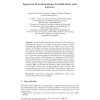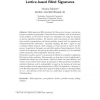18 search results - page 1 / 4 » Concurrently Secure Identification Schemes Based on the Wors... |
ASIACRYPT
2008
Springer
13 years 7 months ago
2008
Springer
In this paper, we show that two variants of Stern's identification scheme [IEEE Transaction on Information Theory '96] are provably secure against concurrent attack unde...
ECCC
2008
13 years 5 months ago
2008
We construct public-key cryptosystems that are secure assuming the worst-case hardness of approximating the minimum distance on n-dimensional lattices to within small poly(n) fact...
EUROCRYPT
2011
Springer
12 years 9 months ago
2011
Springer
Abstract. NTRUEncrypt, proposed in 1996 by Hostein, Pipher and Silverman, is the fastest known lattice-based encryption scheme. Its moderate key-sizes, excellent asymptotic perfor...
PROVSEC
2010
Springer
13 years 3 months ago
2010
Springer
Zero-knowledge identification schemes solve the problem of authenticating one party to another via an insecure channel without disclosing any additional information that might be u...
ASIACRYPT
2010
Springer
13 years 3 months ago
2010
Springer
Blind signatures (BS), introduced by Chaum, have become a cornerstone in privacy-oriented cryptography. Using hard lattice problems, such as the shortest vector problem, as the bas...


